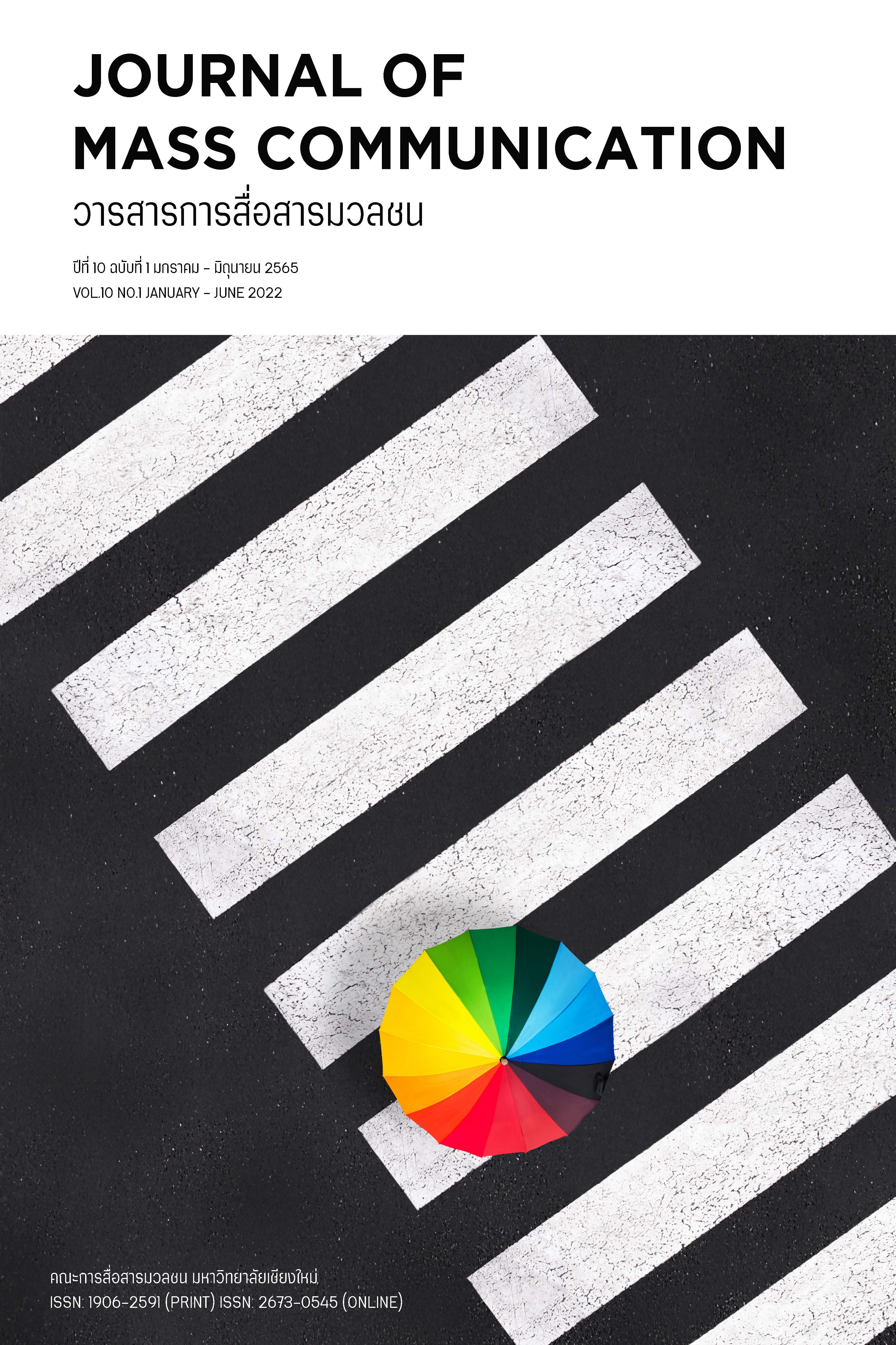รูปแบบการสื่อสารของแฟนคลับนักแสดงซีรี่ส์โทรทัศน์ไทยชายรักชาย
Main Article Content
บทคัดย่อ
งานวิจัยนี้มีวัตถุประสงค์เพื่อศึกษา 1. ลักษณะของแฟนคลับ และ 2. รูปแบบการสื่อสารของแฟนคลับนักแสดงซีรี่ส์โทรทัศน์ไทยชายรักชาย เป็นการวิจัยเชิงคุณภาพ เครื่องมือ คือ แบบสัมภาษณ์เชิงลึก โดยคำถามมีลักษณะปลายเปิดแบบกึ่งโครงสร้าง ผู้ให้ข้อมูลสำคัญ คือ แฟนคลับของนักแสดงซีรี่ส์โทรทัศน์ไทยชายรักชาย อาศัยในเขตกรุงเทพมหานครและปริมณทล โดยผู้วิจัยเจาะจงผู้ให้ข้อมูลสำคัญคนแรก หลังจากนั้นใช้การแนะนำการเลือกผู้ให้ข้อมูลสำคัญคนถัดไปแบบปากต่อปาก ไปยังแฟนคลับคนอื่น ๆ ต่อไปเรื่อยๆ และการสังเกตการณ์แบบไม่มีส่วนร่วมจนกระทั่งมีการอิ่มตัวของข้อมูล จึงได้กลุ่มผู้ให้ข้อมูลสำคัญ จำนวน 28 คน นำเสนอข้อมูลจากการวิจัยด้วยวิธีการนำเสนอข้อมูลเชิงพรรณนา
ผลการวิจัย พบว่า ผู้ให้ข้อมูลสำคัญ อายุตั้งแต่ 13 ปี จนถึง 35 ปี เพศหญิง 24 คน เพศทางเลือก 4 คน เป็นแฟนคลับนักแสดงซีรี่ส์โทรทัศน์ไทยชายรักชายโดยมีที่มา คือ 1. ติดตามเนื้อหาชายรักชายจากนวนิยายอยู่แล้ว 2. สนใจจากเพื่อนและสื่อแนะนำ 3. ติดตามผลงานนักแสดงมาก่อนแล้ว ลักษณะของแฟนคลับมี 2 ลักษณะ คือ แฟนคลับหลัก และแฟนคลับทั่วไป เหตุผลในการเข้ากลุ่มแฟนคลับ 1. ต้องการสนับสนุนนักแสดง 2. ต้องการเป็นพลังในการสื่อสารถึงนักแสดง และ 3. ต้องการส่งเสริมด้านการตลาดให้กับนักแสดง ทิศทางการสื่อสารของแฟนคลับมีลักษณะ 2 ทิศทาง ได้แก่ การสื่อสารแบบเส้นตรงและการสื่อสารแบบวงกลม โดยรูปแบบการสื่อสารของแฟนคลับนักแสดงซีรี่ส์ละครโทรทัศน์ไทยชายรักชาย มี 3 รูปแบบ ได้แก่ การสื่อสารภายในตัวเอง การสื่อสารระหว่างแฟนคลับกับแฟนคลับ การสื่อสารระหว่างแฟนคลับกับนักแสดง
คำสำคัญ: รูปแบบการสื่อสาร, แฟนคลับ, นักแสดงซีรี่ส์ชายรักชาย, ซี่รี่ส์วาย
Article Details

อนุญาตภายใต้เงื่อนไข Creative Commons Attribution-NonCommercial-NoDerivatives 4.0 International License.
ลิขสิทธ์ที่ผู้เขียนบทความต้องยอมรับ
เอกสารอ้างอิง
กิติมา สุรสนธิ. (2542). ความรู้ทางการสื่อสาร. (พิมพ์ครั้งที่ 3). กรุงเทพฯ: คณะวารสารศาสตร์และสื่อสารมวลชน มหาวิทยาลัยธรรมศาสตร์.
จรรยาลักษณ์ สิริกุลนฤมิตร. (2558). องค์ประกอบการสื่อสารและกระแสนิยมเพลงเกาหลีในประเทศไทย. (วิทยานิพนธ์ปริญญามหาบัณฑิต). กรุงเทพฯ: มหาวิทยาลัยธรรมศาสตร์.
จารุภัค อธิวัฒน์ภิญโญ , มนฑิรา ธาดาอำ นวยชัย และ ปีเตอร์ รุ่งเรือนกานต์. (2562, มกราคม – มิถุนายน). การศึกษาพฤติกรรมการเปิดรับสื่อสังคมออนไลน์และการธำรงรักษาของกลุ่มแฟนคลับนักร้องเกาหลีในประเทศไทย กรณีศึกษา ศิลปินวง GOT7. ใน
วารสารวิชาการนวัตกรรมสื่อสารสังคม. 7(1). 220-229.
เจษฎา รัตนาเขมากร. (2541). ศิลปินเพลงไทยและเครือข่ายการสื่อสารกับแฟนคลับ. (วิทยานิพนธ์ปริญญามหาบัณฑิต). กรุงทพฯ: จุฬาลงกรณ์มหาวิทยาลัย.
ชนกานต์ รักชาติและพัชนี เชยจรรยา. (2559). วิธีการสื่อสารและการธำรงอยู่ของกลุ่มแฟนคลับศิลปินนักร้องกลุ่มจากประเทศเกาหลีใต้ในประเทศไทย. ใน วารสารนิเทศศาสตร์และนวัตกรรม นิด้า. 3(1). 163-180.
ณิชชา ยงกิจเจริญ. (2558). การเปิดรับข่าวสาร ทัศนคติ และแนวโน้มพฤติกรรมที่มีต่อศิลปินวง EXO ของกลุ่มแฟนคลับ EXO-L. (วิทยานิพนธ์ปริญญามหาบัณฑิต). กรุงเทพฯ: มหาวิทยาลัยธรรมศาสตร์.
นันทิชา ลือพืช. (2560). การสร้างความหมายและแสดงตัวตนของสาววาย ในพื้นที่ออฟไลน์และพื้นที่ออนไลน์. (วิทยานิพนธ์ปริญญามหาบัณฑิต). กรุงเทพฯ: มหาวิทยาลัยธรรมศาสตร์.
นุชณาภรณ์ สมญาต. (2561). ซีรีส์วาย (Y): ลักษณะเฉพาะและการนำเสนอความรักของชายรักชาย. ใน การนำเสนอโครงการประชุมวิชาการและนำเสนอผลงานระดับชาติของนักศึกษาด้านมนุษยศาสตร์และสังคมศาสตร์ มหาวิทยาลัยราชภัฏสวนสุนันทา.
1(15 กันยายน 2561). 67-83.
บุณยนุช นาคะ. (2560). แฟนคลับเกาหลี อัตลักษณ์เชิงวัตถุและชุมชนแฟนคลับ. (วิทยานิพนธ์ปริญญามหาบัณฑิต). กรุงเทพฯ: มหาวิทยาลัยธรรมศาสตร์.
พิชญาพร ประครองใจ. (2558). หลักนิเทศศาสตร์. กรุงเทพฯ: สำนักพิมพ์แห่งจุฬาลงกรณ์มหาวิทยาลัย
เพิ่มพร ณ นคร และณัฏฐ์วัฒน์ ธนพรรณสิน. (2560). การใช้ทฤษฎีบทบาทหน้าที่ของสื่อกับสื่อมวลชน. ใน วารสารการสื่อสารมวลชน คณะการสื่อสารมวลชน มหาวิทยาลัยเชียงใหม่. 5(2). 144-163.
ภัสวลี นิติเกษตรสุนทร. (2550). หน่วยที่ 1 ความรู้เบื้องต้นเกี่ยวกับการสื่อสารและพฤติกรรมการสื่อสาร. ใน เอกสารการสอนชุดวิชาทฤษฎีและพฤติกรรมการสื่อสาร หน่วยที่ 1-7. นนทบุรี: มหาวิทยาลัยสุโขทัยธรรมาธิราช.
รุจิรา จิตต์ตั้งตรงและพัชนี เชยจรรยา. (2558). กลยุทธ์สื่อบุคคลเพื่อสร้างเครือข่ายการสื่อสารอย่างมีส่วนร่วมเพื่อพัฒนา “เกษตรอินทรีย์”. ใน วารสารการสื่อสารและการจัดการ นิด้า. 1(3). 59-80.
วงหทัย ตันชีวะวงศ์. (2554). การโฆษณาข้ามวัฒนธรรม. กรุงเทพฯ: สำนักพิมพ์มหาวิทยาลัย ธรรมศาสตร์.
สมภพ ติรัตนะประคม. (2542). พฤติกรรมการเปิดรับสื่อสิ่งพิมพ์กับการเลือกท่องเที่ยวในจังหวัดภูเก็ต ของนักท่องเที่ยวชาวไทย. (วิทยานิพนธ์ปริญญามหาบัณฑิต). กรุงเทพฯ: มหาวิทยาลัยหอการค้าไทย.
สมศักดิ์. (2560). การสื่อสารภายในตนเอง. สืบค้น จาก http://www.elfms.ssru.ac.th/somsak_kl/ file.php/1/1-2560/1/7.pdf สืบค้น เมื่อ 18 กุมภาพันธ์ 2564
สุรพงษ์ โสธนะเสถียร. (2533). การสื่อสารกับสังคม. กรุงเทพฯ : โรงพิมพ์จุฬาลงกรณ์มหาวิทยาลัย.
เสนาะ ติเยาว์. (2541). การสื่อสารในองค์การ. พิมพ์ครั้งที่ 4. กรุงเทพฯ: คณะพาณิชยศาสตร์และการบัญชี มหาวิทยาลัยธรรมศาสาตร์.
อภิวัฒน์ น้ำทรัพย์. (2545). ปัจจัยที่เกี่ยวข้องกับพฤติกรรมการซื้อและฟังเทปเพลงไทยสากลและซีดี: กรณีศึกษามหาวิทยาลัยเอกชนระดับปริญญาตรีในเขตกรุงเทพมหานคร. (วิทยานิพนธ์ปริญญามหาบัณฑิต). นนทบุรี: มหาวิทยาลัยธุรกิจบัณฑิต.
อัฎฐ์ กู้พงษ์ศักดิ์. (2558). การบริหารจัดรายการของกิจการโทรทัศน์แบบฟรีทีวีเพื่อผลเชิงพาณิชย์. สืบค้นจาก http://www.bu.ac.th/knowledgecenter/executive_journal/30_2/pdf/ aw3.pdf.
โอห์ม สุขศรี. (2550). การสื่อสารผ่านเว็บไซต์กับการสร้างอัตลักษณ์และสัญญะของกลุ่มแฟนคลับฟุตบอลต่างประเทศ: กรณีศึกษา: เรดอาร์มีแฟนคลับ. (วิทยานิพนธ์ปริญญามหาบัณฑิต). นนทบุรี: มหาวิทยาลัยธุรกิจบัณฑิตย์.
CatDumb News. (2019). กระแส Boy's Love (BL) หรือชายรักชาย. สืบค้น จาก https://www. facebook.com/CatDumbNews/posts/2372784679430974/ สืบค้นเมื่อ 1 มิถุนายน 2564
Catherine Deen. (2014). Formation, Purpose and Gains: An Exploratory Study of Hallyu Fanclubs in the Philippines. In Hallyu Mosaic in the Philippines: Framing Perceptions and Praxis 2014 AIKS Korean Studied
Conference. (19 June). 25-34.
Gray, J., Sandvoss, C. & Harrington, C.L. (2007). Fandom: Identities and Communities in a Mediated World. New York: New York University Press.
Jenson, Joli. (1992). Fandom as Pathology: The Consequence of Characteization. In The_Adoring Audience. Lisa A. Lewis (Eds). London and New York: Routledge Otmazgin, N. & Lyan, I. (2013,). Hallyu across the desert: K-pop fandom in Israel and Palestine. Cross Currents East Asian History and Culture Review, 9. Retrieved from http://cross-currents.berkeley.edu/e-journal/issue-9
McCombs & Becker. (1979). Using mass communication theory. New Jersey: Prenetice Hall, Inc.
McQuail, D. (1994). The Media Audience-Alternative Concept of Audience. An Introduction of Mass Communication Theory. Second edition, California. SAGE Publication.
Thomas Baudinett. (2019). Lovesick, The Series: adapting Japanese ‘Boys love’ to Thailand and the Creation of a new genre of queer media. In South East Asia Research. 27(2), 115-132.
Jenkins, Henry. (1992). Texual Poachers. New York and London: Routledge.
Certeau, D. M. (1984). The practice of everyday life (translated by Steven Rendall. Berkeley: University of California Press.
Gamble, T. K., & Gamble, M. (2005). Communication works. (8th ed.). Boston, MA: McGraw-Hill.
tonkit360. (2560, 22 กันยายน). 10 ศัพท์เฉพาะที่ติ่งเกาหลีต้องรู้. สืบค้น จาก https://www. sanook.com/campus/1386667/ สืบค้น เมื่อ 13 มิถุนายน 2564


